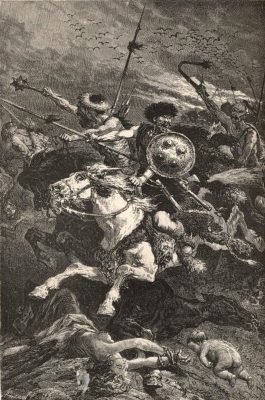The known recorded battles of Attila the Hun include the Siege of Naissus, Battle of the Utus, and Battle of the Catalaunian Plains, among others, from AD 441 to 451 or 453.
In 434, Bleda and Attila the Hun took over the Hunnic Empire. The two co-rulers and brothers finished the peace treaties their uncles arranged with the Eastern Roman Empire and its emperor, Theodosius II. Hence, there was peace between the Roman Empire and the Huns, with the former providing an annual tribute of 317 kg of gold.
However, the Hunnic Empire failed in invading the Persian Empire, and it led to breaking the peace treaty. The Huns started to attack the Eastern Roman Empire in 441, resulting in different confrontations that the king experienced during his reign. There were many battles but among these conflicts was only one loss in 451.
Siege of Naissus
The city of Naissus in Dacia Mediterranea, the birthplace of Constantine the Great, was one of the victims of the Attila’s army in 443. Although not trained in siege warfare, the Hunnic troops with rams and other siege machines breached Naissus even with defenders shooting darts and throwing stones against the attackers.
The siege meant desolation for Naissus even after six years, such as in the historical account of Priscus. The record also documented how the banks around the town were full of bones.
Battle of the Utus
In 447, the Battle of the Utus transpired between the Eastern Roman Empire and Huns led by Attila around the Vit River in present-day Bulgaria. This confrontation served as the culmination of the Hunnic invasion of the Balkan regions that started in 443 and again in 447.
Arnegiscius, commander of foot soldiers of Thrace, led the Roman forces and faced the Huns at Utus in the Dacia Ripensis, a Roman province. The army was possibly composed of troops from Thrace, Illyricum, and the emperor’s soldiers.
Both sides had severe losses, but the Hunnic Empire prevailed due to the indecisiveness of the Roman side. The Huns killed Arnegiscius when his horse was killed, and he had to fight on foot.
In the aftermath, the Hunnic king desired to attack Constantinople, but with heavy losses, he had to abandon besieging the capital. He turned on other Balkan Provinces such as Scythia, Moesia, Thrace, Illyricum, and Roman Dacia. However, Thermopylae was able to halt the siege of the Hunnic Empire.
Battle of the Catalaunian Plains
In June 451, the first and only defeat of Attila took place in the Battle of Catalaunian Plains, also known as the Battle of Chalons. The two sides of the conflict include the Hun Empire and the coalition of Visigoth King Theodoric I and Roman general Flavius Aetius. The former, who had an estimated 200,000 troops, wanted to invade Gaul.
The march to Gaul led waste to some Gallic provinces. However, upon arrival and facing the combined Goth-Roman army, the Hunnic Empire experienced its only loss during the reign of Attila, even if Theodoric died. The Huns had to withdraw with at least 150,000 to 200,000 troops dying from the confrontation for both sides. Even with the defeat, the empire resumed its invasions of Italy in 452.
Other battles and military campaigns
In 441, Attila’s troops did not face opposition from the eastern field armies except for the cities of Margus, Singidunum, Viminacium, and Sirmium. However, the Huns conquered and razed these cities. Its inhabitants became enslaved and used to create fortifications in the middle Danube frontier.
In 443, the Balkan city of Serdica fought against the Hunnic empire, with the latter overcoming the former. The skirmishes that followed were near Constantinople, such as the army led by Aspar, whom the king of the Huns defeated with ease.
In 452, the Huns resumed their military campaign even with the defeat in the Battle of Catalaunian Plains. The Hunnic king seized Aquilela after a 3-month siege followed by razing cities in Po Valley.
